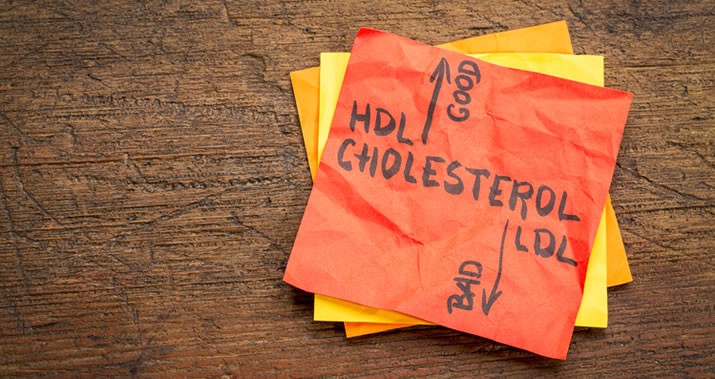
Cholesterol can be confusing. There’s HDL versus LDL, “good” versus “bad,” dietary cholesterol versus serum cholesterol, and of course triglycerides. When you’re just trying to do the best you can for your heart health, navigating the numbers can be a little daunting. Fortunately, it isn’t as complicated as it seems.
HDL Cholesterol
HDL is short for “high density lipoprotein.” This is a form of cholesterol that is cleared from the body via the liver, and does not tend to collect in blood vessels and cause blockages. It also scavenges LDL cholesterol out of the blood, allowing it to be removed by the liver. When it comes to good cholesterol versus bad cholesterol, HDL is considered good because it reduces the risk of cardiovascular disease.
As a rule, more HDL is better. Above a certain point (around 60 ml/dL) it is considered to have a protective effect on the cardiovascular system. Your cholesterol ratio is found by dividing your total cholesterol by your HDL cholesterol. The higher this ratio is, the higher your risk of heart disease.
LDL Cholesterol
LDL is short for “low density lipoprotein.” This cholesterol is more likely to collect in blood vessels, where it can form plaque that cause heart attack, stroke, or peripheral artery disease. Because it contributes to plaque, it is considered bad cholesterol. Sometimes, medical literature references VLDL, or “very low density lipoproteins.” These are compounds made of fats, cholesterol, protein, and fat-soluble vitamins. Like LDL, VLDL contributes to plaque formation by carrying triglycerides into peripheral blood vessels.
Lower LDL levels are better. Optimally, your level of non-HDL cholesterol should be below 130 mg/dL if you are otherwise healthy. If you suffer from cardiovascular disease, your doctor may want your level to be lower — around 100 mg/dL.
Triglycerides
Another important component to your cholesterol health is your triglycerides. Triglycerides are a type of fat that is found in your blood. After you eat, your body stores these natural fats and oils in your blood to use later for fuel. If your body regularly burns less calories than you ingest, the fat in your blood – triglycerides – builds up, raising your triglyceride levels.
A normal range for triglycerides is less than 150 mg/dL. A borderline triglyceride level is 150 to 199 mg/dL. High triglycerides range between 200 to 499 mg/dL. When you have your cholesterol checked via blood test, your doctor should report your triglycerides to you, along with your HDL and LDL levels.
High triglycerides, or hypertriglyceridemia, can lead to thickening of the artery walls and hardening of the arteries. These are dangerous conditions that significantly increase your risk for stroke or heart attack.
Tips for Healthy Levels
Your total cholesterol is LDL + HDL + (triglycerides divided by 5). So if you had an LDL of 110, HDL of 40, and triglyceride level of 150, then the equation would read: 110 + 40 + (150/5). High LDL and triglycerides sometimes do not present symptoms until it is too late, so it isn’t possible to tell if your cholesterol levels are increasing your risk of heart disease without a blood test. Fortunately, these tests are quick, easy, and very routine. Armed with your cholesterol ratio, you can begin doing what you need to in order to protect your heart. A significant portion of your cholesterol ratio is determined by genetics, but not all of it. So, if your numbers are less than perfect, there are things you can do to help boost or lower them as needed:
• Research shows that smoking lowers HDL cholesterol. If you do smoke, quit. If you don’t, don’t start.
• Reduce your waist measurement. A large waist circumference is associated with high levels of LDL cholesterol.
• Avoid simple carbohydrates, including sugar and white flour
• Get at least 30 minutes of exercise, 5 times a week. Something as simple as walking or using a stationary bike can help improve HDL levels.
• Eat more fiber. Fiber is instrumental in encouraging the liver to break down more cholesterol. In a long-term study of diet and aging, fiber was also the one dietary component most associated with “successful aging”- aging without suffering from cancer, heart disease, or diabetes.
• Eat less saturated and trans fat. These fats contribute to higher levels of LDL.
• Use a statin. Statins are a class of medication that helps improve your cholesterol ratio. Most of them work by lowering LDL, but some can actually slightly increase HDL as well.
• Drink in moderation. While too much isn’t healthy, a moderate alcohol intake can help reduce LDL.
• Foods like olive oil, beans, whole grains, nuts, fish and avocado has been shown to raise HDL and lower LDL.
Diet and Cholesterol
For a long time, conventional wisdom held that eating a lot of high-cholesterol foods would raise the levels of cholesterol in your blood. More recently, research has shown that the relationship between dietary and serum cholesterol isn’t quite that simple. Foods high in cholesterol can cause your levels to rise, but only about 33% of people who are particularly sensitive to it. Even then, experts warn that cholesterol is less of a concern then saturated and trans fats — both of which impact the blood’s cholesterol ratio more than dietary cholesterol does.
For decades, cholesterol as a whole was much-maligned as the cause of heart disease. Now, with more recent research and better understanding, we know how different types of cholesterol interact with the human body and each other. By exercising regularly, eating a heart-healthy diet, not smoking, getting tested regularly, and following a doctor’s advice, you can improve your cholesterol ratio and protect your heart, brain, and blood vessels for years to come.